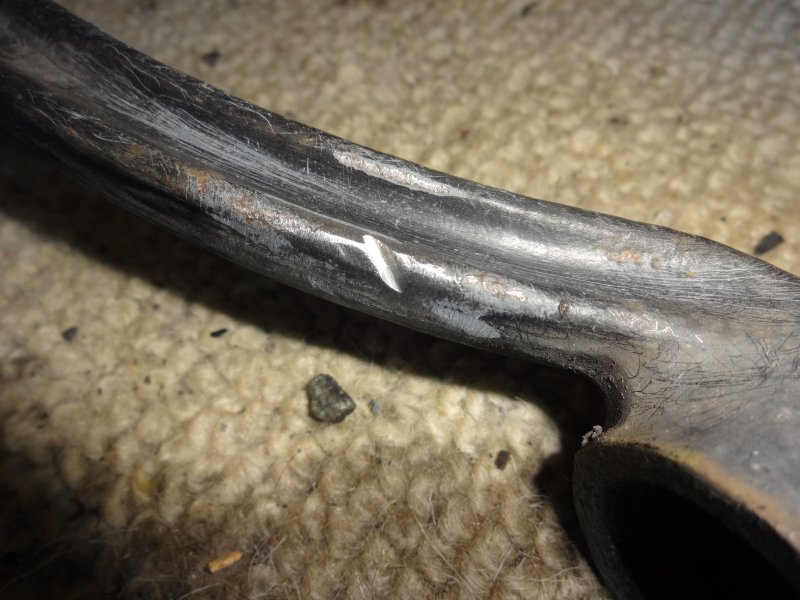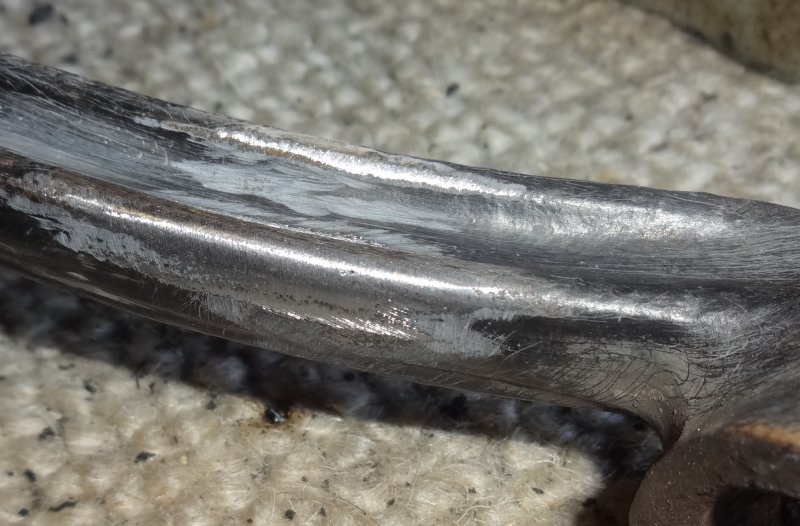upper arm damage
#1
#2
#3
#4
#5
Well many years ago I worked as a Metallurgist at a TRW steering and Suspension factory. What little knowledge may grey matter allows me to retain tells me this;
I suspect the control arms are cast from low carbon steel that have been tempered to relieve the stress caused by the machining and forging process. No high tensile strength heat treating going on to this part.
What Test Point is concerned about, I think, is the heat generated from the welding causing a hardening effect on the steel which "may" make it brittle if it is not tempered again. I do not think this will be an issue as the steel used is most likely not a high enough carbon content to cause an issue.
As for the "nick" in the first place, as long as there were no sharp edges I don't think it was deep enough to cause an issue and the repair by welding is completely acceptable. Without the welding I would have just relieved the edges with a grinder to make it a smooth transition and move on.
Just my 2 cents....
I suspect the control arms are cast from low carbon steel that have been tempered to relieve the stress caused by the machining and forging process. No high tensile strength heat treating going on to this part.
What Test Point is concerned about, I think, is the heat generated from the welding causing a hardening effect on the steel which "may" make it brittle if it is not tempered again. I do not think this will be an issue as the steel used is most likely not a high enough carbon content to cause an issue.
As for the "nick" in the first place, as long as there were no sharp edges I don't think it was deep enough to cause an issue and the repair by welding is completely acceptable. Without the welding I would have just relieved the edges with a grinder to make it a smooth transition and move on.
Just my 2 cents....
Last edited by Jandreu; 10-26-2014 at 11:53 AM. Reason: Edit"corrected mistake about how the control arm is made"
The following users liked this post:
RaceDiagnostics (10-25-2014)
#6
Thanks guys for the comments, I was a bit worried about the welding heat issue.
I was also thinking that the stresses in the part can not actually massively high as the arm is held on to the car by rubber/poly.
On a related topic I was also worried about using too much heat on my lower arms when changing the lower ball joints a couple of years ago, I had considered heating the end of the arms with a butane torch to release the ball joint and then expand it before pushing in the new one, so in the end did not use too much heat.
However I see that it was done sucessfully here https://www.jaguarforums.com/forum/x...t-situ-123638/
What are your thoughts on this, ok or not?
I was also thinking that the stresses in the part can not actually massively high as the arm is held on to the car by rubber/poly.
On a related topic I was also worried about using too much heat on my lower arms when changing the lower ball joints a couple of years ago, I had considered heating the end of the arms with a butane torch to release the ball joint and then expand it before pushing in the new one, so in the end did not use too much heat.
However I see that it was done sucessfully here https://www.jaguarforums.com/forum/x...t-situ-123638/
What are your thoughts on this, ok or not?
#7
With low carbon steel heating is not a big issue. Normally done all the time to remove parts in automotive shops. The only time you have to worry about heating is when you have a high carbon part or surface treatment that has been treated to a high heat with an annealing process to result in a high wear resistant surface, as in the ball on ball joints. If you heat a treated area then you will lose the hardened surface and the part will wear prematurely. With low carbon steel heating and air cooling is not an issue. Now if you quick cool as in a water or oil bath that's a whole other ball game. This can cause surface cracks unless the part is treated to an annealing process.
The following 2 users liked this post by Jandreu:
RaceDiagnostics (10-25-2014),
rocklandjag (10-26-2014)
Trending Topics
#8

Removing that fulcrum bolt was a challenge.
Graham
#9

A long time ago, a Mazda trained metallurgist from Japan made "the new kid" a tool that remains one of his most treasured tools.
He straightened a tire wrench, then heated the chisel end to white-orange. The chisel end was then slowly lowered into a bucket of oil. Not immersed immediately, but slowly lowered to a depth of six inches or so.
What did he do?
That tool could be used as a pry bar, punch, big chisel with complete confidence that it wasn't going to throw a splinter, bend or slip. And it all started with a discarded tire wrench.
#10
Ah yes Grasshopper;
The slow cooling, or slowly lower the tool into oil, produced a tempering effect which hardened the metal. If the part had been left to air cool it would have been soft, if quickly quenched it would have been brittle. This all depends on the carbon content of the material and is a very delicate science. Tool steel, as in the material for crow bars, is generally a mid carbon steel which can be hardened but still is flexible enough to not break.
Your Sansei was very in tune with the way of the material!
What happens is when a part is heated the molecular structure rearranges, how much heat and time you give the molecular structure to "lock" into place is determined by how fast it cools, and determines the properties of the metal.
A good example of this is high speed drill bits. These are made from a high carbon steel. Before machining the blanks are submerged in a high heat salt bath, up to about an inch from the end of the shank, they are then transferred to a mid heat salt bath and finally to a low heat salt bath. This process gives the high carbon content steel a chance to cool very slowly and produce a very hard surface for the cutting edge. The shank which was not submersed while it got hot did not reach the very high heat and was air cooled so it's still soft enough for the drill chuck to bite in and hold the bit.
Ball joints for example are a mid carbon cold formed steel. The "ball" is then subjected to a process that adds a thin layer of carbon which penetrates the surface of the ball. This allows the ball to be hardened for wear resistance while the shank is soft enough to not break off and allows for the machining process for threading.
The slow cooling, or slowly lower the tool into oil, produced a tempering effect which hardened the metal. If the part had been left to air cool it would have been soft, if quickly quenched it would have been brittle. This all depends on the carbon content of the material and is a very delicate science. Tool steel, as in the material for crow bars, is generally a mid carbon steel which can be hardened but still is flexible enough to not break.
Your Sansei was very in tune with the way of the material!
What happens is when a part is heated the molecular structure rearranges, how much heat and time you give the molecular structure to "lock" into place is determined by how fast it cools, and determines the properties of the metal.
A good example of this is high speed drill bits. These are made from a high carbon steel. Before machining the blanks are submerged in a high heat salt bath, up to about an inch from the end of the shank, they are then transferred to a mid heat salt bath and finally to a low heat salt bath. This process gives the high carbon content steel a chance to cool very slowly and produce a very hard surface for the cutting edge. The shank which was not submersed while it got hot did not reach the very high heat and was air cooled so it's still soft enough for the drill chuck to bite in and hold the bit.
Ball joints for example are a mid carbon cold formed steel. The "ball" is then subjected to a process that adds a thin layer of carbon which penetrates the surface of the ball. This allows the ball to be hardened for wear resistance while the shank is soft enough to not break off and allows for the machining process for threading.
Last edited by Jandreu; 10-26-2014 at 12:25 PM.
#11
Many thanks for your elegantly put explanation.
I knew that he was doing something special just by the fact that the whole
shop had stopped in the middle of the day to watch him do his magic.
I have always suspected that the special treatment is what made the tool
a special piece. Now I know
BTW, when working with suspension pieces, what color can you heat to without affecting
the factory applied tempering if any? Dull red?
I knew that he was doing something special just by the fact that the whole
shop had stopped in the middle of the day to watch him do his magic.
I have always suspected that the special treatment is what made the tool
a special piece. Now I know

BTW, when working with suspension pieces, what color can you heat to without affecting
the factory applied tempering if any? Dull red?
#12
With the exception of the actual ball on ball joints and tie rod ends I wouldn't worry about it to much. Again, these parts are not hardened and slow air cooling will return them to their previous state. However if you get too hot, bright red/yellow, you are in dangerous territory for distorting the part. When heating to remove a ball joint from the control arm, no worries as you are replacing the ball joint anyway, not that you could get the ball hot enough to hurt it but you can distort the plastic bushings inside the ball joint as well as ruin the lube inside. Never heat a new ball joint for any reason but you shouldn't have a reason to do that anyway.
Thread
Thread Starter
Forum
Replies
Last Post
Camnelson324
S-Type / S type R Supercharged V8 ( X200 )
3
09-27-2015 08:48 AM
Currently Active Users Viewing This Thread: 1 (0 members and 1 guests)




